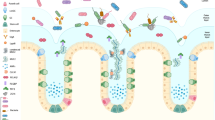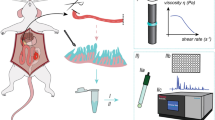Abstract
We hypothesized that two putative gastric protective factors, mucus efflux and residual mucus gel content, would manifest circadian rhythms, as reported in several other gastric functions. Rats were adapted for three weeks on a 12-hr light schedule, fasted 18-hr and studied at 3-hr intervals. Under anesthesia, the stomachs were cannulated and filled with test solution. Thirty minutes later, they were drained and the luminal fluid was analyzed for mucus content by Alcian blue binding. Residual mucus gel was determined by direct injection of dye into the lumen. Alcian blue binding of rat mucus was expressed as equivalent milligrams of porcine mucin. Both parameters showed a significant (P<0.001) circadian rhythm. Mucus efflux peaked at 5:03±0:52 HALO (hours after lights on), and residual mucus at 6:00±0.46 HALO. Thus, the interplay of circadian rhythms in aggressive and defensive gastric mucosal functions is supported.
Similar content being viewed by others
References
Moore JG, Englert E Jr: Circadian rhythm of gastric acid secretion in man. Nature 226:1261–1262, 1970
Moore JG, Halberg F: Circadian rhythm of gastric acid secretion in men with active duodenal ulcer. Dig Dis Sci 31:1185–1191, 1986
Szabo S, Pfeiffer DC, Oishi T: The pharmacology of drug-induced gastric and duodenal ulcers. Chronopharmacology 3:383–384, 1986
Ventura U, Carandente F, Montini E, Ceriani T: Circadian rhythmicity of acid secretion and electrical function in intact and injured rat gastric mucosa—the relation of timing to ulcerogenesis. Chronobiol Int 4:43–52, 1987
Larsen KR, Moore JG, Dayton MT: Circadian rhythms of acid and bicarbonate efflux in the fasting rat stomach. Am J Physiol 260:G610-G614, 1991
El-Alfy M, Leblond CP, Lee ER: Dynamic histology of the antral epithelium in the mouse stomach: V. Proliferation gradient from the gland base to the isthmus at various times of day. Am J Anat 178:65–71, 1987
Dayton MT, Larsen KR, Pigott DC, Nohavec RD, Moore JG: Circadian rhythm of bicarbonate (HCO3 −) secretion in rat stomach. Surg Forum 41:142–144, 1990
Hattori T, Arizono N: Cell kinetics and secretion of mucus in the gastrointestinal mucosa, and their diurnal rhythm. J Clin Gastroenterol 10(suppl 1):S1-S6, 1988
Moore JG, Goo RH: Day and night aspirin-induced gastric mucosal damage and protection by ranitidine in man. Chronobiol Int 4:111–116, 1987
Olsen CE, Soll AH, Guth PH: Circadian variation of susceptibility to gastric mucosal injury by acidified aspirin or absolute ethanol in the rat. Gastroenterology 91:1192–1197, 1986
Waldrop RD, Rubin NH, MacLellan DG, Rayford PL, Thompson JC: Daily variations in the formation of gastric ulcers caused by cervical cord transection in the rat. Gastroenterology 94:1080–1082, 1988
Szabo S, Pihan G: Development and significance of cysteamine and propionitrile models of duodenal ulcer. Chronobiol Int 4:31–42, 1987
Moore JG, Smolensky MH: The chronobiology of peptic ulcer disease and implications for its chronotherapy with H2-receptor antagonists. Annu Rev Chrono-pharmacol 6:113–135, 1989
Shea-Donohue T, Danquechin-Dorval E, Montcalm E, El-Bayar H, Durakovic A, Conklin JJ, Dubois A: Alterations in gastric mucus secretion in Rhesus monkeys after exposure to ionizing radiation. Gastroenterology 88:685–690, 1985
Halberg F, Halberg E: Appendix: Terms for methods and facts in chronopharmacology.In Toward Chronopharmacology. R Takahashi, F Halberg, CA Walker (eds). Oxford, Pergamon, 1982, pp 391–423
McQueen S, Hutton D, Allen A, Garner A: Gastric and duodenal surface mucus gel thickness in rat: Effects of prostaglandins and damaging agents. Am J Physiology 245:G388-G393, 1983
Piper DW, Whitecross D, Leonard P, Clarke A: Alcian blue dye binding properties of gastric juice. Gastroenterology 59:534–538, 1970
Bolton JP, Palmer D, Cohen MM: Stimulation of mucus and non-parietal cell secretion by the E2 prostaglandins. Am J Dig Dis 23:359–364, 1978
Impicciatore M, Marini G, Chiavarini M, Plazzi PV, Agosti A, Soldani G: Mucus and pepsin role in gastric damage prevention by H2-receptor antagonists and anti-ulcer drugs. Acta Physiol Hung 64:253–257, 1984
Kauffman GL: Gastric mucus and bicarbonate secretion in relation to mucosal protection. J Clin Gastroenterol 3(suppl 2):45–50, 1981
Davenport HW, Warner HA, Code CF: Functional significance of gastric mucosal barrier to sodium. Gastroenterology 47:142–152, 1964
Heatley NG: Mucosubstance as a barrier to diffusion. Gastroenterology 37:313–317, 1959
Flemstrom G: Properties of isolated gastric antral and SCN-inhibited fundic mucosa.In Gastric Hydrogen Ion Secretion. DK Kasbekar, G Sachs, WS Rehm (eds). New York, Dekker, 1977, pp 102–116
Flemstrom G: Active alkalinization by amphibian gastric fundic mucosain vitro. Am J Physiol 233:E1-E12, 1977
Garner A, Flemstrom G: Gastric HCO3 − secretion in the guinea pig. Am J Physiol 234:E535-E541, 1978
Williams SE, Turnberg LA: Demonstration of a pH gradient across mucus adherent to rabbit gastric mucosa: Evidence for a ‘mucus-bicarbonate’ barrier. Gut 22:94–96, 1981
Allen A: Structure and function of gastrointestinal mucus glycoproteins and the viscus and gel forming properties of mucus. Br Med Bull 34:28–33, 1978
Allen A, Snary D: The structure and function of gastric mucus. Gut 13:666–672, 1972
Allen A, Snary D, Pain RH: Model for the structure of the gastric mucus gel. Nature 264:88–89, 1976
Holm L, Flemström G: Microscopy of acid transport at the gastric surface in vivo. J Int Med 228(suppl 1):91–95, 1990
Allen A, Carroll NJ: Adherent and soluble mucus in the stomach and duodenum. Dig Dis Sci 30:555–625, 1985
Yonei Y, Holzer P, Guth PH: Laparotomy-induced gastric protection against ethanol injury is mediated by capsaicin-sensitive sensory neurons. Gastroenterology 99:3–9, 1990
Höller H: Untersuchungen über sekret und sekretion der cardiadrüsenzone im magen des schweines. I. Sekretions-volumina und- rhythmik, eigenschaften der sekrete. Zentralbl Veterinarmed (A) 17:685–711, 1970
Carandente F, Halberg F: Chronobiologic view of shift work and ulcer.In Shift Work and Health. PG Rentos, RD Shepard (eds). HEW Publication No (NIOSH) 76-203, 1976, pp 273–283
Author information
Authors and Affiliations
Rights and permissions
About this article
Cite this article
Larsen, K.R., Moore, J.G. & Dayton, M.T. Circadian rhythms of gastric mucus efflux and residual mucus gel in the fasting rat stomach. Digest Dis Sci 36, 1550–1555 (1991). https://doi.org/10.1007/BF01296396
Received:
Revised:
Accepted:
Issue Date:
DOI: https://doi.org/10.1007/BF01296396




